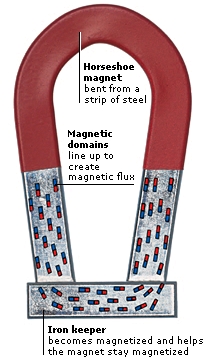DK Science: Magnetism
Magnetism is what gives magnets their ability to attract objects made of iron or steel. A magnet creates around itself a region of space with special properties. This region is known as a MAGNETIC FIELD. When two magnets come near each other, their fields create forces that attract or repel. The Earth is itself a huge magnet, and the force its field exerts on other magnets makes them point in a north–south direction. This effect is used in the magnetic compass.
The most common magnetic material is steel, an alloy (mix) of iron, other metals, and carbon. Pure iron becomes magnetized in a magnetic field but does not stay magnetic. Steel can make a permanent magnet. Once it is magnetized, it stays magnetized.
The two ends of a magnet are always different from each other. The end that points north, if allowed to move freely, is called the north pole. The other end is the south pole. These magnetic poles behave rather like electric charges. Poles of opposite kinds attract each other, while poles of the same kind repel.
Magnetic materials are made of thousands of tiny magnets called magnetic domains. Before the material is magnetized, all the little magnets point in different directions, so their effects cancel each other out. But a magnetic field can line them up so that they all point in the same direction. This turns the material into a magnet.

A magnet often has an iron keeper to help it stay magnetized. A magnet creates a magnetic flux, which is rather like a current flowing through an electrical circuit – although in a magnet, nothing actually moves. A high magnetic flux keeps the magnet’s domains lined up. Materials that let a lot of flux through are said to have high permeability. Iron has high permeability, so it makes a good keeper.

Magnetism was first discovered in a natural rock called magnetite, or lodestone. Its strange property of attracting iron objects was known nearly 3,000 years ago. Later, Chinese explorers discovered that a piece of lodestone, if able to move freely, would always point north. This led to the development of the compass.
Every magnet is surrounded by an invisible, three-dimensional magnetic field. A field is a region in which something varies from point to point. In Earth’s atmosphere, for example, wind speed and direction vary from place to place. In a magnetic field, the strength and direction of the magnetic effect varies in a similar way. The field is at its strongest near the magnet.

This modern compass has a pivoted magnetic needle. The needle points not to the Earth’s geographical North Pole but to its magnetic north pole. This is in northern Canada, about 1,600 km (1,000 miles) from the North Pole. The magnetic north pole is currently moving northwards at about 40 km (25 miles) a year.
The idea of a field is based on the work of British scientist Michael Faraday (1791–1867) in the early 19th century. He sprinkled particles of iron around magnets to reveal what he called “lines of force” stretching from one pole to another. These helped him to explain many magnetic effects. We now see lines of force as indicating the direction of the field, with their spacing indicating its strength.
Magnetic Resonance Imaging (MRI) lets doctors look deep inside people’s bodies. Doctors put patients into a giant magnet and probe them with radio waves. The waves make molecules in the body vibrate. The rate of vibration depends on the type of molecule. Different parts of the body contain different molecules, so each part shows up clearly.
Scientists measure magnetic fields with an instrument called a magnetometer. The instrument can also be used to measure the magnetism in ancient rocks. As the rocks formed, they were magnetized by the Earth’s field. Rocks of different ages may be magnetized in opposite directions, because the Earth’s magnetic field has often reversed. By piecing together records from different places, scientists can work out how rocks have moved in the billions of years since the Earth was formed.
The Earth acts like a huge magnet, and its magnetic field (the magnetosphere) extends far into space. Although its centre is made of iron, it is too hot to be a permanent magnet. This is because high temperatures destroy magnetism. The field probably comes from molten, charged material circulating inside the Earth.
